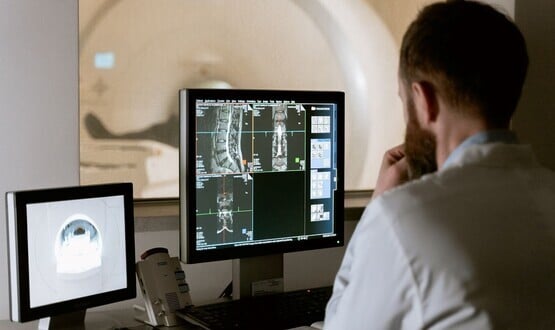Trawling the archives
- 9 October 2013

The refresh of picture and archiving communications systems that is now underway in England is giving trusts the opportunity to think about their long-term imaging strategies.
The PACS systems installed through the National PACS Programme a decade ago delivered significant efficiency and workflow improvements to radiology departments.
But they also have limitations: a lack of compatibility between the systems makes it hard to share images with other departments or institutions.
Increasingly, clinicians want to be able to work collaboratively with colleagues. If a patient has been referred from a general hospital, for example, to a specialist clinic in the same trust, it helps if the specialist can see any images that have already been taken.
The Image Exchange Portal, introduced jointly by the Department of Health and Burnbank Systems (now owned by Sectra), addressed this by allowing trusts to send images to each other on request.
Although it has worked well, this “push” model is time-consuming, and can result in multiple copies of a single image being kept in different places.
Alternatively, a radiologist may want to see, not just the patient’s images, but other documents associated with the case.
Currently this involves opening up a different application, usually from a separate workstation, and finding the relevant documents.
This poses a particular problem when a clinician is at a patient’s bedside and needs access to detailed information.
“The challenge NHS systems have today is they don’t deliver information at the point of care,” says Mark O’Herlihy, director of healthcare, EMEA, at Perceptive Software.
“So when a clinician is in front of a patient on a ward, he only has the visibility of what is available on the ward at the time. He can see the radiology images, but nothing related in context to that.”
Standards are key
The solution that some trusts are now turning to is the vendor neutral archive. A VNA is a standards-based repository, which means that it should be able to store PACS images from any supplier, as long as they are in DICOM format.
Despite its name, however, the VNA is much more than a place for long-term storage of images.
VNAs are sometimes grouped into four levels, from the simplest, level 1, which links images together for the same patient, to level 4, which uses the XDS standard to allow the cross-enterprise sharing of any unstructured content.
An XDS-enabled VNA includes a document repository for storing documents and responding to document retrieval requests, and a document registry, which stores information about the documents, making it easy to retrieve documents (or images) related to an individual patient.
In a true VNA, says O’Herlihy, the XDS repository and registry should be part of the core VNA system, rather than bolted on via a third party.
A patient-centric view
Doncaster and Bassetlaw Hospitals NHS Foundation Trust, which has just undergone a PACS refresh, has adopted a PACS, a VNA and a radiology information system from three different vendors.
Neelam Dugar, consultant radiologist at the trust, says the key clinical benefit of the VNA (which is being provided by Acuo) is the ability to see information relating to a single patient. “With one click you have access to all the information that needs to be shared,” she says.
The trust’s VNA will store relevant documents, with the emphasis on “relevant”. “It needs to be useful to other clinicians,” she says. “We don’t want to put in every single little document that we’ve got.”
Dr Dugar believes the main documents held in the VNA should be “referral letters, clinic letters, discharge summaries from when the patient visited the ward – summarising things for every episode of care.
“Radiology will be using the VNA to store the radiology request card, the radiology images and the radiology report.
At the Whittington Hospital, which has purchased a VNA from Sectra, the long-term aim is also to bring different types of data together.
David Grant, chief information officer of Whittington Health, says: “From a clinician’s point of view, if they want to see things other than imaging, or contextualise the imaging in terms of: ‘This is the imaging, now what did the discharge summary show?’ or: ‘What did the outpatient letter show?’, they’ll be available on the VNA.”
Once a VNA is implemented, different departments, such as radiology and cardiology, do not have to rely on using the same PACS supplier to share images, says O’Herlihy: they can employ a best-of-breed strategy across multiple systems and still see the images they require at the point of care.
The longer-term benefit of VNAs is that they can allow the sharing of images between institutions. Acuo is implementing a VNA for the whole of the Wales NHS. Originally purchased as a radiology archive, the VNA is being expanded to include breast screening and cardiology images.
John Davidson, market development manager, of GE Healthcare, points to a similar example in Sweden, where seven hospitals using PACS from different providers all have access to a single VNA.
“They’re using it to do shared workflow where one hospital is asking for a second opinion from another hospital.
“Overnight, rather than every single hospital having radiologists on board, they have a pool of radiologists shared across all seven teams, and any hospital is able to nominate an exam into the pool to be picked up by the on-call radiologists.
“So they’re starting to use these archives in different ways, rather than just some place to secure your image.”
It is not necessary to have a single, central archive to share images, however, says Davidson, provided the VNA has a federated architecture.
“As long as you’ve got a single XDS registry that will point to different repositories that exist within each trust you can share. What you’re doing is getting the image streamed to your desktop rather than physically moving it from that location to your local system.”
Cutting costs
From a financial point of view, a VNA enables a trust to avoid vendor lock-in, says O’Herlihy, enabling them to grow at a pace that suits them rather than at the pace their existing vendor allows them.
They can switch PACS supplier, for example, without the substantial overheads of integration and migration – something that will resonate with trusts currently undergoing a painful transition to their new PACS systems.
Charles Yeomanson, IT director of University Hospitals Coventry and Warwickshire NHS Trust, which has recently purchased a Visbion VNA, says: “When we went through this exercise of moving off the national solution, we were extracting images from the national archive for the last year. In future, what we don’t want to do whenever we move supplier is to take a year to move the data.”
Simplifying IT
Some VNAs incorporate both disaster recovery and automated lifecycle management, allowing the IT function to save money on storage.
The biggest win for IT, however, is that they have a “single clinical repository to manage as opposed to multiple ones,” says O’Herlihy.
“Chief information officers save money on virtualisation, they can decide if they want to have a second copy of an offsite data centre or hosted, and it allows them to connect multiple disparate sites by not having to deploy applications locally.”
The rise of the VNA is gradual, and trusts won’t reap the full benefits of cross-enterprise sharing until take-up is more widespread. But some trusts are beginning to recognise that the VNA offers much more than a means of storing images.
Rather than a replacement for a PACS archive, says O’Herlihy, trusts are starting to see VNAs as an “infrastructure and enterprise buy.”
Vendor neutral archives will be just one of the issues discussed at the EHI Live 2013 conference and exhibition at the NEC in Birmingham from 5-6 November. This year’s conference is free for all visitors to attend.




